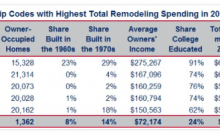The Microkitchen: An Urban Trend?
The Microkitchen: An Urban Trend?
DAILY NEWS
Kitchens have become grand – filled with large granite islands and a spacious area for entire families to gather besides just for cooking. But in urban tech centers, kitchens are increasingly getting a makeover from younger owners who are desiring a smaller, high-tech area. Read more: ‘Tiny Condos’ Draw Millennials to Ownership The area may be small but its focus on technology is a big deal. The microkitchen is often stocked with pricey blenders, elaborate coffee makers, and professional-quality knives. “It suits digital workers who eat free at work or take their meals in homey but globally influenced restaurants in their apartment buildings,” notes the article at The New York Times. “Dinner may come from one of a dozen app-based delivery services, either as a fully prepared chef’s special or a meal kit that requires cooking but not much chopping.” There’s still cooking that does occur in the microkitchen, but a large area for food preparation is no longer viewed as important. “People are willing to shrink the square footage of their kitchen for more versatility and more open space to entertain guests,” Jolee Nebert, 22, a student of industrial design at Western Washington University who last year created a fully functioning kitchen into a six-foot-long unit and won a design competition held at General Electric’s experimental factory for it. “It’s about packing more into less space.” Apartment dwellers have long had to deal with tiny kitchens as a matter of necessity, not by choice. “But these microkitchens are now being embraced by a group of early adopters who could easily afford much larger ones, and whose culinary preferences could shape kitchen design for years to come,” The New York Times reports. “The transformation is playing out most vividly in the technology corridors of several American cities, where developers and real estate agents say condominiums and apartments designed with well-equipped minikitchens are being sought by young people whose food expenditures are surpassed only by their rent.” For example, Sam Jenkins, a real estate professional in Chicago, says he is selling condos for $300,000 to $600,000 with downsized kitchens that have more space for entertaining and larger bedrooms – it’s what millennials prefer than a big kitchen, he says. Appliance makers are taking note. General Electric, Miele and Bosch report an increase in demand for smaller stoves that have been trimmed by six inches, dishwashers that are 18 inches wide, and refrigerators that are set inside drawers. “If you look at the purchases among millennials, you see a picture of people trying to get more freshness out of these small kitchens quicker,” Darren Cypher, a food and beverage industry analyst at NPD, told The New York Times. Source: “Small Kitchens, By Choice,” The New York Times (Dec. 7, 2015)
Kitchens have become grand – filled with large granite islands and a spacious area for entire families to gather besides just for cooking. But in urban tech centers, kitchens are increasingly getting a makeover from younger owners who are desiring a smaller, high-tech area.
Read more: ‘Tiny Condos’ Draw Millennials to Ownership
The area may be small but its focus on technology is a big deal. The microkitchen is often stocked with pricey blenders, elaborate coffee makers, and professional-quality knives. “It suits digital workers who eat free at work or take their meals in homey but globally influenced restaurants in their apartment buildings,” notes the article at The New York Times. “Dinner may come from one of a dozen app-based delivery services, either as a fully prepared chef’s special or a meal kit that requires cooking but not much chopping.”
There’s still cooking that does occur in the microkitchen, but a large area for food preparation is no longer viewed as important.
“People are willing to shrink the square footage of their kitchen for more versatility and more open space to entertain guests,” Jolee Nebert, 22, a student of industrial design at Western Washington University who last year created a fully functioning kitchen into a six-foot-long unit and won a design competition held at General Electric’s experimental factory for it. “It’s about packing more into less space.”
Apartment dwellers have long had to deal with tiny kitchens as a matter of necessity, not by choice.
“But these microkitchens are now being embraced by a group of early adopters who could easily afford much larger ones, and whose culinary preferences could shape kitchen design for years to come,” The New York Times reports. “The transformation is playing out most vividly in the technology corridors of several American cities, where developers and real estate agents say condominiums and apartments designed with well-equipped minikitchens are being sought by young people whose food expenditures are surpassed only by their rent.”
For example, Sam Jenkins, a real estate professional in Chicago, says he is selling condos for $300,000 to $600,000 with downsized kitchens that have more space for entertaining and larger bedrooms – it’s what millennials prefer than a big kitchen, he says.
Appliance makers are taking note. General Electric, Miele and Bosch report an increase in demand for smaller stoves that have been trimmed by six inches, dishwashers that are 18 inches wide, and refrigerators that are set inside drawers.
“If you look at the purchases among millennials, you see a picture of people trying to get more freshness out of these small kitchens quicker,” Darren Cypher, a food and beverage industry analyst at NPD, told The New York Times.
Source: “Small Kitchens, By Choice,” The New York Times (Dec. 7, 2015)


